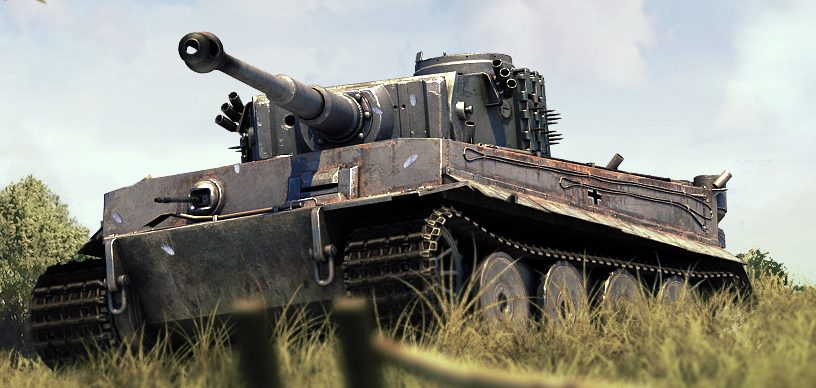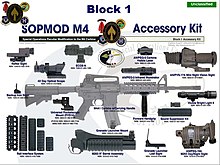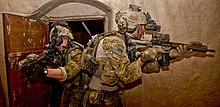SOPMOD Block I
U.S. Special Operations Command (USSOCOM) developed the Special Operations Peculiar Modification (SOPMOD) Block I kit for the carbines used by units under its jurisdiction. The kit features an M4A1, a Rail Interface System (RIS) handguard developed by Knight’s Armament Company, a shortened quick-detachable M203 grenade launcher and leaf sight, a KAC sound suppressor, a KAC back-up rear sight, an Insight Technologies AN/PEQ-2A visible laser/infrared designator, along with Trijicon’s ACOG TA-01NSN model and Reflex sights, and a night vision sight. This kit was designed to be configurable (modular) for various missions, and the kit is currently in service with special operations units.
SOPMOD Block II
A second-generation SOPMOD kit (now known as SOPMOD II) includes innovative optics, such as the Elcan Specter DR, Trijicon’s ACOG TA01 ECOS model, and the Eotech 553. Block II uses the RIS II rails manufactured by Daniel Defense in both a 9.5 and 12.5 length.
Variants
Except for the very first delivery order, all U.S. military-issue M4 and M4A1 carbines possess a flat-top NATO M1913-specification (Picatinny) rail on top of the receiver for attachment of optical sights and other aiming devices — Trijicon TA01 and TA31 Advanced Combat Optical Gunsights (ACOG), EOTech 550 series holographic sights, and Aimpoint M68 Close Combat Optic (M68 CCO) being the favorite choices — and a detachable rail-mounted carrying handle. Standards are the Colt Model 920 (M4) and 921 (M4A1).
Variants of the carbine built by different manufacturers are also in service with many other foreign special forces units, such as the Australian Special Air Service Regiment (SASR). While the SASR uses weapons of essentially the same pattern built by Colt for export (Colt uses different models to separate weapons for the U.S. military and those for commercial/export purposes), the British SAS uses a variant on the basic theme, the Colt Canada (formerly Diemaco) C8SFW.
M4 MWS (Modular Weapon System)
M4 MWS (Modular Weapon System) shown with various accessories including M203 grenade launcher, RIS foregrip, removable carry handle/rear sight assembly, AN/PEQ-4laser system, M68 CCO reflex sight, and the AN/PVS-4 night vision optics
Colt Model 925 carbines were tested and fitted with the Knight’s Armament Corporation (KAC) M4 RAS under the designation M4E2, but this designation appears to have been scrapped in favor of mounting this system to existing carbines without changing the designation. The U.S. Army Field Manual specifies for the Army that adding the Rail Adapter System (RAS) turns the weapon into the M4 MWS or Modular Weapon System.
M4A1
M4A1 with TA01NSN ACOG 4×32 optical sight
The M4A1 carbine is a fully automatic variant of the basic M4 carbine intended for special operations use. The M4A1 was introduced in May 1991, and was in service in 1994. The M4A1 has a “S-1-F” (safe/semi-automatic/fully automatic) trigger group, while the M4 has a “S-1-3” (safe/semi-automatic/3-round burst) trigger group. The M4A1 is used by almost all U.S special operation units including, but not limited to, Marine Force Recon, Army Rangers, Army Special Forces, Navy SEALs, United States Air Force Pararescue and Air Force Combat Control Teams. It has a maximum effective range of about 500 to 600 meters (550–660 yd).[7] The fully automatic trigger gives a more consistent trigger pull, which leads to better accuracy.[37] According to Mark A. Westrom, owner of ArmaLite, Inc., automatic fire is better for clearing rooms than burst fire.[38]
In the last few years, M4A1 carbines have been refitted or received straight from the factory with barrels with a thicker profile under the handguard. This is for a variety of reasons such as heat dissipation during full-auto, and accuracy as a byproduct of barrel weight. These heavier barrel weapons are also fitted with a heavier buffer known as the H2. Out of three sliding weights inside the buffer, the H2 possesses two tungsten weights and one steel weight, versus the standard H buffer, which uses one tungsten weight and two steel weights. These weapons, known by Colt as the Model 921HB (for Heavy Barrel), have also been designated M4A1, and as far as the government is concerned the M4A1 represents both the 921 and 921HB.
Conversion of M4s to the M4A1 began in 2014, the start of all U.S. Army forces being equipped with the automatic variant.[39] Though in service with special forces, combat in Afghanistan showed the need for providing automatic suppression fires during fire and movement for regular soldiers. The 101st Airborne Division began fielding new-built M4A1s in 2012, and the U.S. 1st Infantry Division became the first unit to convert their M4s to M4A1-standard in May 2014. Upgrades included a heavier barrel to better dissipate heat from sustained automatic firing, which also helps the rifles use the M855A1 EPR that has higher proof pressures and puts more strain on barrels. The full-auto trigger group has a more consistent trigger pull, whereas the burst group’s pull varies on where the fire control group is set, resulting in more predictable and better accuracy on semi-automatic fire. Another addition is an ambidextrous selector lever for easier use with left-handed shooters. The M4-M4A1 conversion only increases weapon weight from 7.46 lb (3.38 kg) to 7.74 lb (3.51 kg), counting a back-up iron sight, forward pistol grip, empty magazine, and sling. Each carbine upgrade costs $240 per rifle, for a total cost of $120 million for half a million conversions. 300 conversions can be done per day to equip a brigade combat team per week, with all M4A1 conversions to be completed by 2019.[40][41]
Mark 18 CQBR
The Mk 18 Close Quarters Battle Receiver is an M4A1 with a 10.3-inch barrel upper receiver.[42] Current contractors for the Mark 18 are Colt and Lewis Machine & Tool (LMT) NSN 1005-01-527-2288.
Enhanced M4
For the Individual Carbine competition, Colt submitted their Enhanced M4 design, also known as the Colt Advanced Piston Carbine (APC). The weapon has a suppression-ready fluted barrel, which is lighter and cools better than previous M4 barrels. It is claimed to have “markedly better” accuracy. To improve reliability, Colt used an articulating link piston (ALP), which “reduces the inherent stress in the piston stroke by allowing for deflection and thermal expansion”.[43] In traditional gas piston operating systems, the force of the piston striking the bolt carrier can push the bolt carrier downwards and into the wall of the buffer tube, leading to accelerated wear and even chipped metal. This is known as carrier tilt. The ALP allows the operating rod to wiggle to correct for the downward pressure on the bolt and transfers the force straight backwards in line with the bore and buffer assembly, eliminating the carrier tilt. This relieves stress on parts and helps to increase accuracy.[44] The Individual Carbine competition was canceled before a winning weapon was chosen.[37]
Colt Commando
Though Colt has focused its attention on carbines with 14.5-inch barrels and rifles with 20-inch barrels, Colt continues to make carbines with 11.5-inch barrels, which it calls Commandos. The Colt Model 733, is their first design, and it was made in 1987. It was referred to as the M16A2 Commando, and later the M4 Commando. Unlike the XM177, the Colt Commando was a shorter variant of the M16A2. Originally, Commandos were assembled from whatever spare parts are available, so Model 733 Commandos could have A1-style upper receivers with case deflectors or A2-style upper receivers, and M16A1-profile 1:7 or M16A2-profile 1:7 barrels. Depending on the specific models, Commandos may have had three-position fire control groups (safe/semi-automatic/three-round burst), or four-position having both full-automatic and burst. The modern Model 933 has a “flattop” receiver, with a removable carrying handle and a MIL-STD-1913 Picatinny rail, with semi-automatic and automatic fire. The Model 935 Commando has the features of the Model 933, but has three-round burst fire instead of automatic. Though originally called the M16A2 Commando, Colt markets them as the M4 Commando around 1995.
Armwest LLC M4
In 2014, American firearms designer Jim Sullivan provided a video interview regarding his contributions to the M16/M4 family of rifles when working for Armalite. A noted critic of the M4, he illustrates the deficiencies found in the rifle in its current configuration. In the video, he demonstrates his “Arm West LLC modified M4”, with enhancements he believes necessary to rectify the issues with the weapon. Proprietary issues aside, the weapon is said to borrow features in his prior development, the Ultimax. Sullivan has stated (without exact details as to how) the weapon can fire from the closed bolt in semi-automatic and switch to open bolt when firing in fully automatic, improving accuracy. The weight of the cyclic components of the gun has been doubled (while retaining the weapon’s weight at less than 8 pounds). Compared to the standard M4, which in automatic fires 750-950 rounds a minute, the rate of fire of the Arm West M4 is heavily reduced both to save ammunition and reduce barrel wear. The reduced rate also renders the weapon more controllable and accurate in automatic firing.[45]
Performance
A U.S. Navy sailor fires an M4 carbine from the warship USS Vella Gulf.
The M4 carbine has been used for close quarters operations where the M16 would be too long and bulky to use effectively. It has been a compact, light, customizable, and accurate weapon. This has come at the cost of reliability and maintainability. Failure to maintain the M4 causes malfunctions. This became apparent as it saw continued use in the sandy environments of Iraq and Afghanistan.[46] Despite this, in post-combat surveys, 94 percent of soldiers rated the M4 as an effective weapons system.[47]
Early feedback
By late 2002, 89 percent of U.S. troops reported they were confident with the M4, but they had a range of problems. 34 percent of users said the handguards rattled and became excessively hot when firing, and 15 percent had trouble zeroing the M68 Close Combat Optic. 35 percent added barber brushes and 24 percent added dental picks to their cleaning kits. There were many malfunctions, including 20 percent of users experiencing a double feed, 15 percent experiencing feeding jams, and 13 percent saying that feeding problems were due to magazines. 20 percent of users were dissatisfied with weapon maintenance. Some had trouble locking the magazine into the weapon and having to chamber a round in order to lock the magazine. Soldiers also asked for a larger round to be able to kill targets with one shot. New optics and handguards made usage of the M4 easier, and good weapon maintenance reduced the number of misfeeds.[48]
2006 CNA report
In December 2006, the Center for Naval Analyses released a report on U.S. small arms in combat. The CNA conducted surveys on 2,608 troops returning from combat in Iraq and Afghanistan over the past 12 months. Only troops who fired their weapons at enemy targets were allowed to participate. 917 troops were armed with M4 Carbines, making up 35 percent of the survey. 89 percent of M4 users (816 troops) reported they were satisfied with the weapon. 90 percent (825 troops) were satisfied with handling qualities such as handguards, size, and weight. M4 users had the highest levels of satisfaction with weapon performance, including 94 percent (862 troops) with accuracy, 92 percent (844 troops) with range, and 93 percent (853 troops) with rate of fire. Only 19 percent of M4 users (174 troops) reported a stoppage, while 82 percent of those that experienced a stoppage said it had little impact on their ability to clear the stoppage and re-engage their target. 53 percent of the M4 users (486 troops) never experienced failures of their magazines to feed. 81 percent (743 troops) did not need their rifles repaired while in theater. 80 percent (734 troops) were confident in the M4’s reliability, defined as level of soldier confidence their weapon will fire without malfunction, and 83 percent (761 troops) were confident in its durability, defined as level of soldier confidence their weapon will not break or need repair. Both factors were attributed to high levels of soldiers performing their own maintenance. 54 percent of M4 users offered recommendations for improvements. 20 percent of requests were for greater bullet lethality, and 10 percent was better quality magazines, as well as other minor recommendations. Some M16 users expressed their desire to be issued the M4.[49] Some issues have been addressed with the issuing of the improved STANAG magazine in March 2009,[50][51] and the M855A1 Enhanced Performance Round in June 2010.[52]
2007 dust test
In the fall 2007, the Army tested the M4 against three other carbines in “sandstorm conditions” at Aberdeen Proving Ground, Maryland: the Heckler & Koch XM8, Fabrique Nationale de Herstal SOF Combat Assault Rifle (SCAR) and the Heckler & Koch HK416. Ten of each type of rifle were used to fire 6,000 rounds each, for a total of 60,000 rounds per rifle type.[53] The M4 suffered far more stoppages than its competitors: 882 stoppages, 19 requiring an armorer to fix. The XM8 had the fewest stoppages, 116 minor stoppages and 11 major ones, followed by the FN SCAR with 226 stoppages and the HK416 with 233.[54][55]
Despite 863 minor stoppages—termed “class one” stoppages, which require 10 seconds or less to clear, or “class two” stoppages, which require more than ten seconds to clear—the M4 functioned well, with over 98 percent of the 60,000 total rounds firing without a problem. The Army said it planned to improve the M4 with a new cold-hammer-forged barrel to give longer life and more reliable magazines to reduce the stoppages. Magazine failures caused 239 of the M4’s 882 failures. Army officials said the new magazines could be combat-ready by spring if testing went well.[56] The Army began issuing an improved STANAG magazine in March 2009.[50][51]
According to the Army, the M4 only suffered 296 stoppages, and said that the high number reported could be attributed to discrepancies in the scoring process. The Army testing command stated that, if the number of stoppages caused by a broken part met some threshold, they would be eliminated from the final report pending redesign of the part. Colt also claimed that the testing conditions were unfair to the M4, as the M4s used in the test were normal guns from active inventory, with remaining service life varying randomly. Further, the trial M4s had burst-mode fire groups, which are more complicated and prone to failure than the fully automatic fire groups the other manufacturers presented for testing.[57]
There were three extreme dust tests performed in 2007. The 2nd Summer 2007 results showed a large difference from the later fall test with the M4 having 148 class 1 stoppages due to rifle malfunctions and 148 class 1 stoppages due to magazine stoppages. The full-size M16 rifle had 61 stoppages during the same extreme dust test.[58]
Reliability
In early 2010, two journalists from the New York Times spent three months with soldiers and Marines in Afghanistan. While there, they questioned around 100 infantrymen about the reliability of their M4 Carbines, as well as the M16 rifle. Troops did not report to be suffering reliability problems with their rifles. While only 100 troops were asked, they fought at least a dozen intense engagements in Helmand Province, where the ground is covered in fine powdered sand (called “moon dust” by troops) that can stick to firearms. Weapons were often dusty, wet, and covered in mud. Intense firefights lasted hours with several magazines being expended. Only one soldier reported a jam when his M16 was covered in mud after climbing out of a canal. The weapon was cleared and resumed firing with the next chambered round. Furthermore, a Marine Chief Warrant Officer reported that there were no issues with his battalion‘s 700 M4s and 350 M16s.[59]
The reliability of the M4 has increased as the design was upgraded. In 1990, the M4 was required to fire 600 mean rounds between stoppages using M855 ammunition. In 2013, the current M4A1 version can fire 1,691 mean rounds between stoppages using M855A1 ammunition.[60]
During the 2009 Marine Corps Infantry Automatic Rifle testing, the Colt IAR displayed a MRBS of CLASS I/II Stoppages of 952 rounds, with a MRBEFF of Class III Stoppages of 60,000 rounds.[61]
Gas piston
An array of firearms accessory makers have offered gas piston conversion kits for the M4. The claimed benefits include less needed lubrication for the bolt carrier group to run reliably and reduced fouling.[62] The argument against it is increased weight and reduced accuracy.[citation needed] The Enhanced M4 uses an articulating link piston operating system.
Complicating the Army search for higher reliability in the M4 is a number of observations of M4 gas piston alternatives that suffer unintended design problems. The first is that many of the gas piston modifications for the M4 isolate the piston so that piston jams or related malfunction require the entire weapon be disassembled, such disassembly cannot be performed by the end user and requires a qualified armorer to perform out of field, whereas almost any malfunction with the direct-impingement system can be fixed by the end user in field. The second is that gas piston alternatives use an off-axis operation of the piston that can introduce carrier tilt, whereby the bolt carrier fails to enter the buffer tube at a straight angle, resulting in part wearing. This can also tilt the bolt during extraction, leading to increased bolt lug failures. The third is that the use of a sound suppressor results in hot gases entering the chamber, regardless of a direct-gas impingement or gas piston design choice. The gas piston system may also cause the firearm to become proprietary to the manufacturer, making modifications and changes with parts from other manufacturers difficult.








